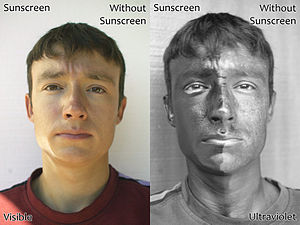| English: Two photographs of a man wearing sunscreen (spf 50) on one half of his face, in visible light (left) and ultraviolet light (UV-A, 340-355nm) (right). The sunscreen on the left side of his face absorbs ultraviolet, making that side appear darker in the UV picture. (Photo credit: Wikipedia) |
Most of the time, the Sun Protection Factor (SPF) blocks more UVB rays, which cause sunburns or other superficial damage to skin, than UVA rays, which penetrate into deeper layers of skin and cause extreme damage to living tissues. Both UVA and UVB rays cause cancer cells to develop within skin tissue.
According to experts, a higher SPF does not necessarily means a significantly higher protection level. For instance, an SPF of 15 most likely blocks only 94% of UVB rays while a sunscreen with SPF 30 probably filters only 97% of UVB rays. A skin care product with SPF 45 or even 50 possibly screens about 98% of UVB rays. However, any sunscreen or skin whitening lotion with more than SPF 50 always contains 99.99% protection.
Similarly, the effectiveness of sun protective clothing is measured by its Ultraviolet Protection Factor (UPF). Fabric with UPF 15 to 24 usually blocks 93.3 to 95.9 percent of UV radiation. To filter about 96.0% to 97.4% of UV rays, the fabric must have a UPF range of 25 to 39. Finally, a sun protective textile must have at least a UPF of 40 or more (50+) to effectively filter about 97.5% to 99.9% of UV radiation.






Comments
Post a Comment
Tell me what you think.